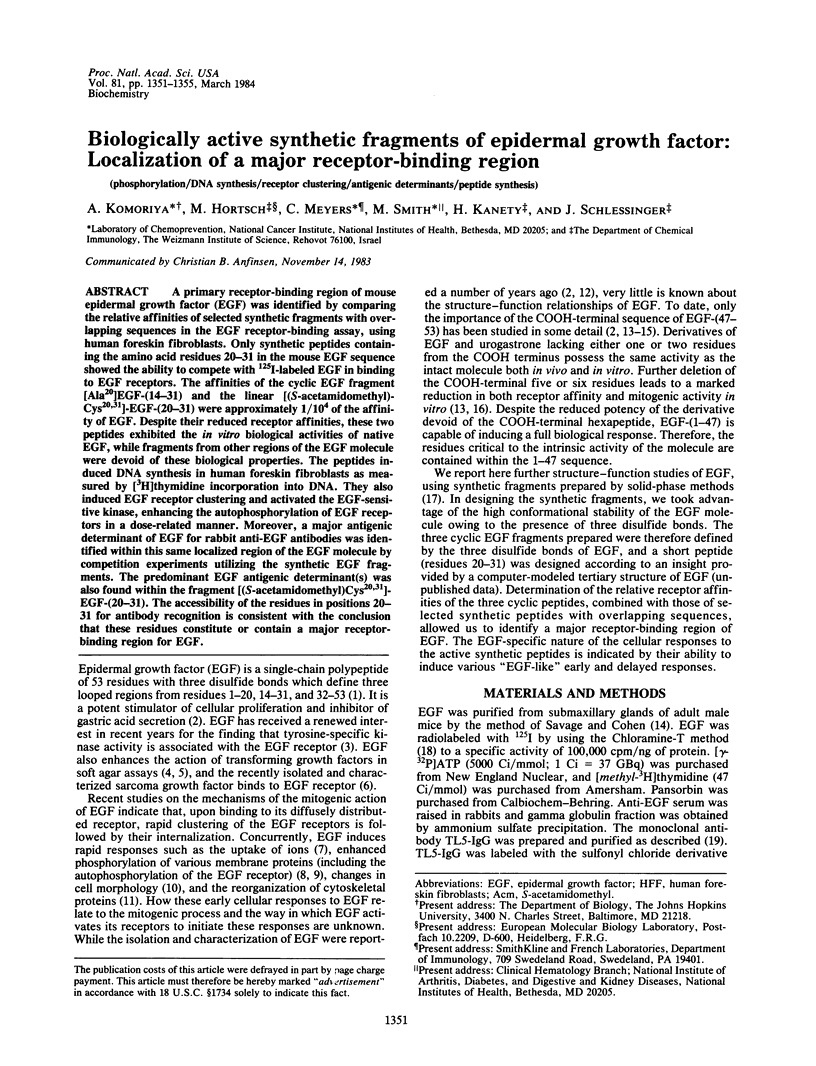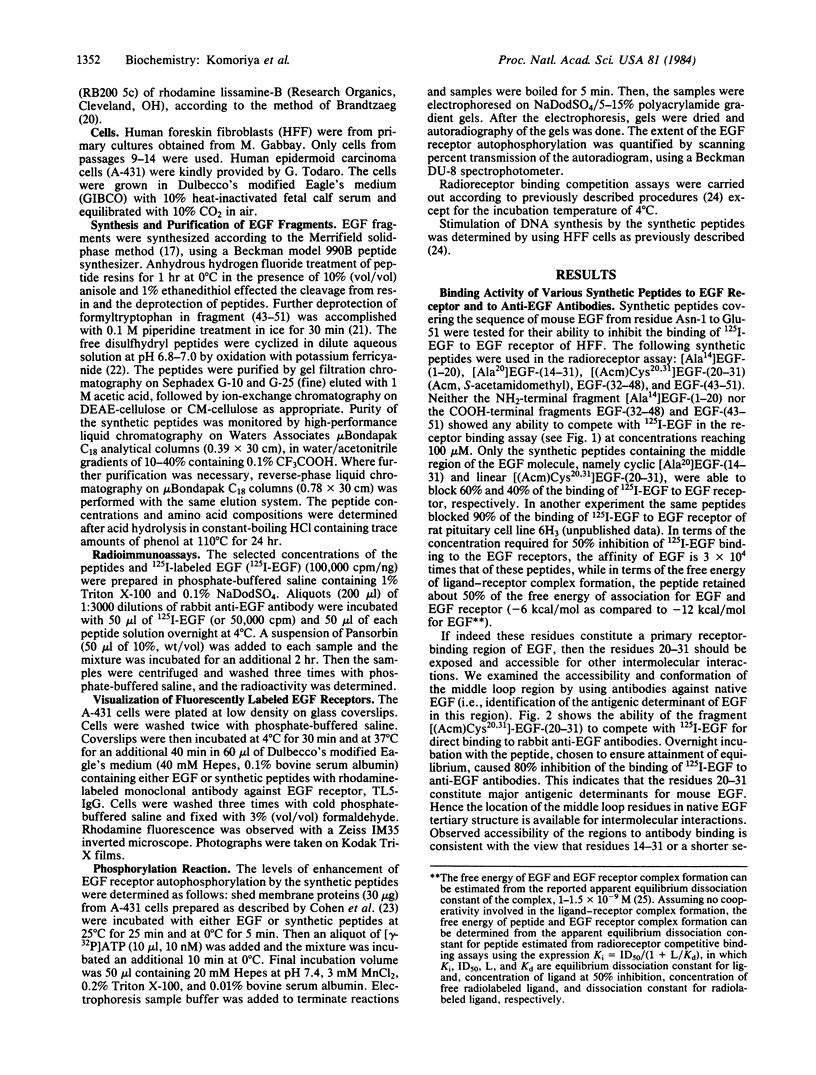Abstract
A primary receptor-binding region of mouse epidermal growth factor (EGF) was identified by comparing the relative affinities of selected synthetic fragments with overlapping sequences in the EGF receptor-binding assay, using human foreskin fibroblasts. Only synthetic peptides containing the amino acid residues 20-31 in the mouse EGF sequence showed the ability to compete with 125I-labeled EGF in binding to EGF receptors. The affinities of the cyclic EGF fragment [Ala20]EGF-(14-31) and the linear [(S-acetamidomethyl)-Cys20,31]-EGF-(20-31) were approximately 1/10(4) of the affinity of EGF. Despite their reduced receptor affinities, these two peptides exhibited the in vitro biological activities of native EGF, while fragments from other regions of the EGF molecule were devoid of these biological properties. The peptides induced DNA synthesis in human foreskin fibroblasts as measured by [3H]thymidine incorporation into DNA. They also induced EGF receptor clustering and activated the EGF-sensitive kinase, enhancing the autophosphorylation of EGF receptors in a dose-related manner. Moreover, a major antigenic determinant of EGF for rabbit anti-EGF antibodies was identified within this same localized region of the EGF molecule by competition experiments utilizing the synthetic EGF fragments. The predominant EGF antigenic determinant(s) was also found within the fragment [(S-acetamidomethyl)Cys20,31]-EGF-(20-31). The accessibility of the residues in positions 20-31 for antibody recognition is consistent with the conclusion that these residues constitute or contain a major receptor-binding region for EGF.
Full text
PDF




Images in this article
Selected References
These references are in PubMed. This may not be the complete list of references from this article.
- Anfinsen C. B. Principles that govern the folding of protein chains. Science. 1973 Jul 20;181(4096):223–230. doi: 10.1126/science.181.4096.223. [DOI] [PubMed] [Google Scholar]
- Brandtzaeg P. Conjugates of immunoglobulin G with different fluorochromes. I. Characterization by anionic-exchange chromatography. Scand J Immunol. 1973;2(3):273–290. doi: 10.1111/j.1365-3083.1973.tb02037.x. [DOI] [PubMed] [Google Scholar]
- Buhrow S. A., Cohen S., Staros J. V. Affinity labeling of the protein kinase associated with the epidermal growth factor receptor in membrane vesicles from A431 cells. J Biol Chem. 1982 Apr 25;257(8):4019–4022. [PubMed] [Google Scholar]
- COHEN S. Isolation of a mouse submaxillary gland protein accelerating incisor eruption and eyelid opening in the new-born animal. J Biol Chem. 1962 May;237:1555–1562. [PubMed] [Google Scholar]
- Carpenter G., King L., Jr, Cohen S. Epidermal growth factor stimulates phosphorylation in membrane preparations in vitro. Nature. 1978 Nov 23;276(5686):409–410. doi: 10.1038/276409a0. [DOI] [PubMed] [Google Scholar]
- Carpenter G., King L., Jr, Cohen S. Rapid enhancement of protein phosphorylation in A-431 cell membrane preparations by epidermal growth factor. J Biol Chem. 1979 Jun 10;254(11):4884–4891. [PubMed] [Google Scholar]
- Chinkers M., McKanna J. A., Cohen S. Rapid induction of morphological changes in human carcinoma cells A-431 by epidermal growth factors. J Cell Biol. 1979 Oct;83(1):260–265. doi: 10.1083/jcb.83.1.260. [DOI] [PMC free article] [PubMed] [Google Scholar]
- Cohen S., Carpenter G. Human epidermal growth factor: isolation and chemical and biological properties. Proc Natl Acad Sci U S A. 1975 Apr;72(4):1317–1321. doi: 10.1073/pnas.72.4.1317. [DOI] [PMC free article] [PubMed] [Google Scholar]
- Cohen S., Ushiro H., Stoscheck C., Chinkers M. A native 170,000 epidermal growth factor receptor-kinase complex from shed plasma membrane vesicles. J Biol Chem. 1982 Feb 10;257(3):1523–1531. [PubMed] [Google Scholar]
- Gregory H. Isolation and structure of urogastrone and its relationship to epidermal growth factor. Nature. 1975 Sep 25;257(5524):325–327. doi: 10.1038/257325a0. [DOI] [PubMed] [Google Scholar]
- HOPE D. B., MURTI V. V., DU VIGNEAUD V. A highly potent analogue of oxytocin, desamino-oxytocin. J Biol Chem. 1962 May;237:1563–1566. [PubMed] [Google Scholar]
- HUNTER W. M., GREENWOOD F. C. Preparation of iodine-131 labelled human growth hormone of high specific activity. Nature. 1962 May 5;194:495–496. doi: 10.1038/194495a0. [DOI] [PubMed] [Google Scholar]
- Holladay L. A., Savage C. R., Jr, Cohen S., Puett D. Conformation and unfolding thermodynamics of epidermal growth factor and derivatives. Biochemistry. 1976 Jun 15;15(12):2624–2633. doi: 10.1021/bi00657a023. [DOI] [PubMed] [Google Scholar]
- Hollenberg M. D. Epidermal growth factor-urogastrone, a polypeptide acquiring hormonal status. Vitam Horm. 1979;37:69–110. doi: 10.1016/s0083-6729(08)61068-7. [DOI] [PubMed] [Google Scholar]
- Hollenberg M. D., Gregory H. Epidermal growth factor-urogastrone: biological activity and receptor binding of derivatives. Mol Pharmacol. 1980 May;17(3):314–320. [PubMed] [Google Scholar]
- Rozengurt E., Heppel L. A. Serum rapidly stimulates ouabain-sensitive 86-RB+ influx in quiescent 3T3 cells. Proc Natl Acad Sci U S A. 1975 Nov;72(11):4492–4495. doi: 10.1073/pnas.72.11.4492. [DOI] [PMC free article] [PubMed] [Google Scholar]
- Savage C. R., Jr, Cohen S. Epidermal growth factor and a new derivative. Rapid isolation procedures and biological and chemical characterization. J Biol Chem. 1972 Dec 10;247(23):7609–7611. [PubMed] [Google Scholar]
- Savage C. R., Jr, Inagami T., Cohen S. The primary structure of epidermal growth factor. J Biol Chem. 1972 Dec 10;247(23):7612–7621. [PubMed] [Google Scholar]
- Schlessinger J., Geiger B. Epidermal growth factor induces redistribution of actin and alpha-actinin in human epidermal carcinoma cells. Exp Cell Res. 1981 Aug;134(2):273–279. doi: 10.1016/0014-4827(81)90426-2. [DOI] [PubMed] [Google Scholar]
- Schreiber A. B., Libermann T. A., Lax I., Yarden Y., Schlessinger J. Biological role of epidermal growth factor-receptor clustering. Investigation with monoclonal anti-receptor antibodies. J Biol Chem. 1983 Jan 25;258(2):846–853. [PubMed] [Google Scholar]
- Schreiber A. B., Yarden Y., Schlessinger J. A non-mitogenic analogue of epidermal growth factor enhances the phosphorylation of endogenous membrane proteins. Biochem Biophys Res Commun. 1981 Jul 30;101(2):517–523. doi: 10.1016/0006-291x(81)91290-0. [DOI] [PubMed] [Google Scholar]
- Ushiro H., Cohen S. Identification of phosphotyrosine as a product of epidermal growth factor-activated protein kinase in A-431 cell membranes. J Biol Chem. 1980 Sep 25;255(18):8363–8365. [PubMed] [Google Scholar]
- Weitzel G., Eisele K., Schulz V., Stock W. Structure and activity of insulin. XII. Further studies on biologically acitve synthetic fragments of the B-chain. Hoppe Seylers Z Physiol Chem. 1973 Mar;354(3):321–330. doi: 10.1515/bchm2.1973.354.1.321. [DOI] [PubMed] [Google Scholar]
- Wood S. P., Blundell T. L., Wollmer A., Lazarus N. R., Neville R. W. The relation of conformation and association of insulin to receptor binding; x-ray and circular-dichroism studies on bovine and hystricomorph insulins. Eur J Biochem. 1975 Jul 15;55(3):531–542. doi: 10.1111/j.1432-1033.1975.tb02190.x. [DOI] [PubMed] [Google Scholar]
- Wright D. E., Rodbell M. Glucagon1-6 binds to the glucagon receptor and activates hepatic adenylate cyclase. J Biol Chem. 1979 Jan 25;254(2):268–269. [PubMed] [Google Scholar]
- de Larco J. E., Todaro G. J. Growth factors from murine sarcoma virus-transformed cells. Proc Natl Acad Sci U S A. 1978 Aug;75(8):4001–4005. doi: 10.1073/pnas.75.8.4001. [DOI] [PMC free article] [PubMed] [Google Scholar]








